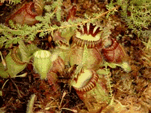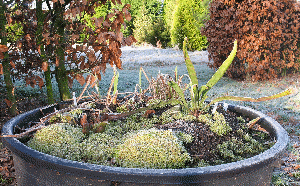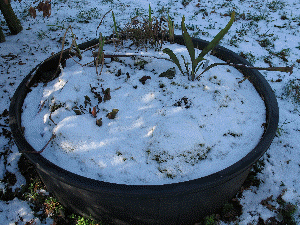

Making a Bog Garden for Carnivorous Plants in the garden
Quite a few hardy carnivorous plants can be grown
outside,
even in the Netherlands! But you cannot just plant them in with your
flowers
or vegetables. The soil and water is wrong and there is too much food
(nitrogen)
in the soil. You need to make a bog or swamp for them. The site must be
in
full sun, although you can get away with having some shade at times.
CPs
grow in bogs where they are open to full sun with perhaps the odd pine
tree
providing shade. It can be any size, but a larger one will hold more
water
in it during dry periods.
 What do you want to grow in the bog? You can grow Sarracenia
(Sarracenia
purpurea ssp. purpurea is the hardiest varity as it grows in Canada),
Darlingtonia,
Venus flytraps, hardy sundews and butterworts that form a resting bud.
Sarracenia
will form a clump in few years and can self seed itself if insect
pollinated.
Drosera will self seed easily the first year, and plants like D.
filiformis,
D. binata and VFTs will also form clumps over time. So take time to
work
out what plants you would like to grow then add space for the growth
and
self seeding of plants. Our native Sundews, D. intermedia and D.
rotundifolia,
and also D. filiformis and D. anglica, prefer drier parts of the
bog,
and grow at different levels away from pools that form in a bogs.
What do you want to grow in the bog? You can grow Sarracenia
(Sarracenia
purpurea ssp. purpurea is the hardiest varity as it grows in Canada),
Darlingtonia,
Venus flytraps, hardy sundews and butterworts that form a resting bud.
Sarracenia
will form a clump in few years and can self seed itself if insect
pollinated.
Drosera will self seed easily the first year, and plants like D.
filiformis,
D. binata and VFTs will also form clumps over time. So take time to
work
out what plants you would like to grow then add space for the growth
and
self seeding of plants. Our native Sundews, D. intermedia and D.
rotundifolia,
and also D. filiformis and D. anglica, prefer drier parts of the
bog,
and grow at different levels away from pools that form in a bogs.
Try and place the bog away from trees that lose their leaves over
winter,
as these dead leaves can lead to the loss of your plants due to mould
and
fungi which CPs are particularly susceptible to over the winter. The
rotting
leaves will also kill the winter buds of Pinguicula and Drosera and as
the
foliage rots, nutrients will be added to the soil, enriching it
possibly
to the detriment of your CPs.
A hose spray or water mister is handy when it has not rained for some
time
in order to keep the moss and smaller CPs from suffering from the
effects
of low humidity. This can be avoided by using bog grasses like in
nature,
although put the taller grasses at the back to avoid hiding the smaller
CPs.
You may get heathers and mosses growing from the peat, so from time to
time
you will need to cut this back away from your CPs.
You can make the bog just like you would a pond, but fill it with peat
instead
of just water. If you already have a pond you can make a bog in it at
one
edge or along side it. A ready-made moulded plastic or fiberglass pond,
or
a flexible pond liner can be used to make the hole waterproof. When you
dig
the hole for the bog make sure you dig to a sufficient depth to hold an
adequate
amount of water, otherwise the sun will dry up your bog too quickly. If
you
use a pond liner, line the hole first with and old carpet, cardboard or
even
sand to stop any sharp stones making a hole in the liner. The water and
soil
in the bog will be heavy and any sharp objects under the liner will
pierce
it.
You can also build a wooden rail around the bog to bring the level of
the
liner about 3 inches (7 cm) above the level of the garden soil. This is
for
two reasons: one is to stop the muddy rain water washing into the bog,
and
the other is to put a layer of bark chippings around the bog which
prevents
snails and slugs from getting at your nice CPs. This is not 100%
effective,
but it certainly helps. It can also stop the grass cuttings from going
onto
your bog! If you use a plastic pond or container, leaving it on the
ground
(not digging a hole) will do the same thing.
 Once the hole is
lined, fill it first with about 6 inches (15 cm) of perlite
followed by 2 inches (5 cm) of Sphagnum moss peat which acts like a
wick
and pulls the water up from the reservoir (perlite) base.
Once the hole is
lined, fill it first with about 6 inches (15 cm) of perlite
followed by 2 inches (5 cm) of Sphagnum moss peat which acts like a
wick
and pulls the water up from the reservoir (perlite) base.
The rest is a mix of Sphagnum moss peat, perlite and silver sand - a
common
mix ratio is 3:1:1. You could use peat and perlite, or peat and sand in
equal
amounts instead. To hide the perlite and stop it being washed away,
finish
the bog off with a layer of peat and sand or sphagnum moss. Make small
hills
and dips in the peat to give wetter and drier areas into which you can
plant
suitable CPs. One important point is when you make the bog you give a
run-off
area on one side for the rain as not all your plants will appreciate
being
under water over winter and especially rainy times. Wet all the peat
with
rainwater as you go and finish off with plants and sphagnun moss (which
helps
keep it humid).
Remember you do not need to have a big garden to have CP bog as you can
also do something similar with big pot or patio planter on your patio.
Just
ensure that it is water tight and use the same soil mix as above. You
can
drill holes into the side of the container just below the soil surface
to
ensure it does not become flooded in winter and the plants rot away.
Even
in the wilds a bog has an area that acts like an over flow in wetter
times,
so plants are not underwater for too long. Smaller pots are more mobile
and
if you live somewhere with particularly cold winters then you can then
just
move these pots into a greenhouse or a sheltered area for protection.
This
type of bog planting can also be done inside the greenhouse for the
more
tender CPs, to show them off in a natural looking bog setting.
